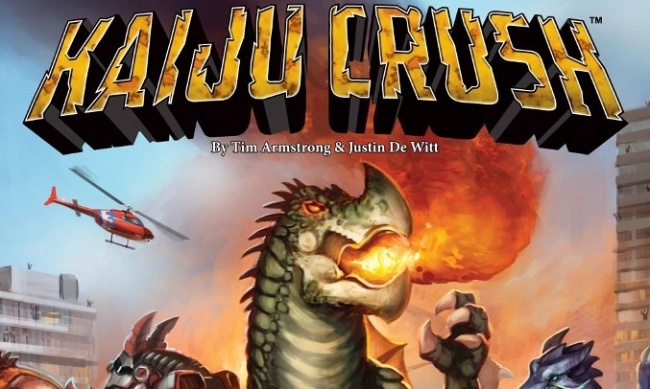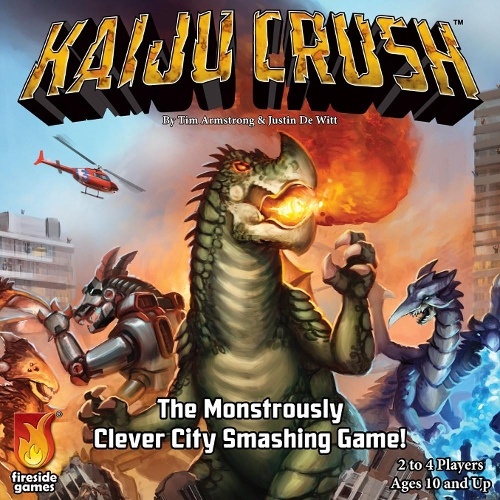Kaiju Crush
Publisher: Fireside Games
Release Date: November 1, 2017
Price: $29.95
Game Designer(s): Tim Armstrong and Justin De Witt
Format: Board Game
Number of Players: 2 to 4
Playing Time: 45 minute
Product #: FSD 1009
Age Rating: 10 and up
ICv2 Rating: 3.5 Stars out of 5
There’s something about giant monsters. Who can forget the first time they heard the roar of Godzilla or the sight of Fay Wray struggling in the hand of King Kong? Also known by the Japanese term kaiju, meaning "strange beast," these movie monsters have inspired a number of games over the years. The most recent being Kaiju Crush from Fireside Games. But is this little game big enough to be king of the monsters?
Summary: In Kaiju Crush, each player controls a giant monster bent on destruction in a nameless city. But destruction alone is not enough to satisfy their appetite, because what they really want to do is dominate all the other giant monsters. So, in addition to the rampant destruction of buildings, the monsters also attack each other with claw, tail, and flaming breath. The monster that can best prove its power through destruction and battle wins the game.
The game is played on a board composed of tiles, each showing some kind of building. Destroying a building is surprisingly easy for the kaiju: all they have to do is walk over to it and it comes crumbling down. Which is good, because you score points for every building you destroy, and that’s where most of your points come from. Movement is controlled by the movement cards, each showing one way that a monster can move such as one space diagonally or two spaces in a straight line. There is one card available to all players, plus each player has one card of their own. But, if you use your own card, you must swap it with the shared card, so the movement options of all players shifts during the game.
Monster combat is resolved using a card-driven variation on the classic Rock, Scissors, Paper mechanic, while random one-use powers and individual abilities give each monster a slight edge in certain situations. To round it all off, variable victory conditions award points based on the patterns of destruction you can create and bonuses for destroying a specific type of building.
Originality: The interesting thing with Kaiju Crush is the way that seemingly unrelated game mechanics are brought together in an innovative if unexpected way. Movement takes place on a limited grid, which shrinks as buildings are destroyed since monsters cannot return to empty spaces. The combat system turns out to be surprisingly interesting and exciting, and variable victory conditions offer a lot of playing variety. The game system is easy to learn, play is quick yet offers a lot of strategic depth, and there is a high level of replayability.
Presentation: The box art does a good job of embracing the cliche without being overly silly. The obligatory fire-breathing dinosaur dominates the cover, flanked by other iconic giant monsters: a robo-lizard and a two-headed flying something-or-other—A nice tip of the hat to the original Japanese movie monsters. The box back nicely depicts the game play and components, which themselves are attractive and engaging. The decision to use cardboard stand-ups instead of cool plastic monsters is disappointing, but certainly effective at controlling the costs and keeping the price point low.
Quality: The component quality is very good here. The tiles are thick and sturdy, as are the monster stand-ups. The goal cards and random power cards are printed on good stock, and the tokens are robust. The box is strong and sized appropriately for the components inside. The combat cards seem a bit thin to me, but not enough so that I worry about them standing up to repeated shuffling. The rulebook is attractive, with glossy paper and lots of colorful examples of play. I wish that they were more clear on a number of points, as we had some questions after reading the rules, but the game system is simple enough that figuring out the answers didn’t give us much trouble.
Marketability: Kaiju Crush is packaged in a smallish square box, so it has a smaller footprint than one might expect from a game about really big monsters. But personally, I’m glad to see games packaged in boxes that are the "right size" for the components: ecological considerations aside, space is at a premium for any serious game collector. The price point is quite friendly, and Fireside Games has a proven track record and a developed fan base. Casual strategy games are hot, so there is definitely room for a game like this in the market.
Overall: The combination of gameplay elements makes Kaiju Crush a fun little game. In particular, balancing your limited movement options with the shrinking tile grid offers up a lot of interesting tactical challenges and rewards careful planning. However, I felt that luck played a disproportionate role in what is, at heart, an abstract strategy type of game. Starting position, turn order, special abilities, the goals of the game, even the points awarded for victory in battle are all random, and if a lucky player has a number of these line up in their favor, they can leap into an early lead that the others may be hard-pressed to balance out. In a quick little filler, it’s not a game breaker to be sure, but it may cause consternation for some.
Kaiju Crush is a "strange beast" for sure, combining elements of abstract strategy, mindless mayhem, and timeless mechanics into a chimera that is hard to categorize. But overall, the game is fun, and its quirks easy to overlook. That’s why I’m giving this game 3.5 out of 5.
-- William Niebling

ICv2 Stars: 3.5 (out of 5)
Posted by William Niebling on October 17, 2017 @ 4:30 am CT



